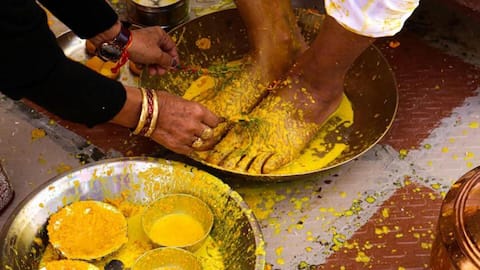Decoding Indian wedding traditions and rituals
What's the story
Indian weddings are a mesmerizing blend of tradition, luxury, and profound emotions. The diverse customs and rituals add a unique touch, making these celebrations truly extraordinary. Beyond the grandeur, each ritual holds profound significance, fostering emotional and spiritual bonds between families. Let us look into some of these Indian wedding traditions, uncovering the fascinating beliefs that make these ceremonies an indelible part of the country's cultural fabric.
Tradition 1
Tearing the groom's clothes
In Sindhi weddings, a rather unusual tradition known as "saanth" involves the ceremonial tearing of the groom's clothes. The clothes represent the groom's single life and since he won't be single anymore the clothes are torn to take their bachelorhood away from them. This ritual is accompanied by breaking an earthen pot to usher in good luck, ward off evil, and bless the groom.
Tradition 2
Money garland
In most North Indian weddings, grooms are donned with garlands made entirely of money, symbolizing respect and emphasizing the groom's intrinsic worth. This unique tradition underlines the belief that material wealth is trivial compared to the value of the groom, adding a distinctive charm to the ceremony while highlighting the cultural significance of wealth and honor.
Tradition 3
Knocking over kalash
Welcoming the bride and groom to the groom's home involves a traditional aarti, a ceremonial gesture rich with cultural symbolism. The bride, symbolizing abundance and prosperity, enters by knocking over a pot of rice. Her footsteps, imprinted in red paste, serve as a symbolic act of paying homage to Goddess Lakshmi, infusing the union with divine blessings and auspiciousness. This adds a spiritual dimension and reflects the deep-rooted cultural ties within Indian households.
Tradition 4
Haldi
A commonality across Indian communities, the haldi ceremony is a vibrant celebration of purity and protection. Turmeric paste, believed to possess healing properties and the ability to ward off negative energies, is applied liberally to the couple's skin. The separation of families during this ceremony is a cultural nuance that preserves the sanctity of the event, enhancing the spiritual significance and adding a layer of anticipation to the union.
Tradition 5
Mehendi
Predominant in the North, the mehendi function is a fascinating display of artistry where intricate henna designs adorn the bride's hands and legs, often inscribed with her to-be husband's name. The depth of color in the mehendi is thought to symbolize the love and acceptance the bride will receive from her spouse and in-laws, adding a touch of mystique to the wedding preparations and fostering a sense of cultural continuity.
